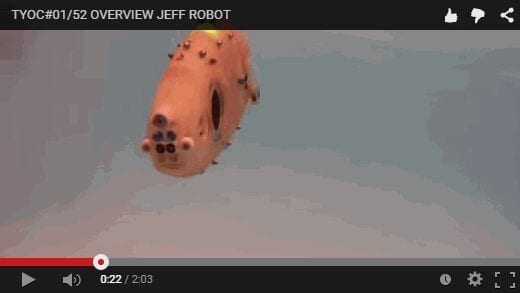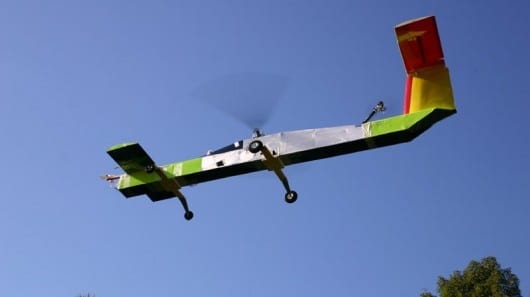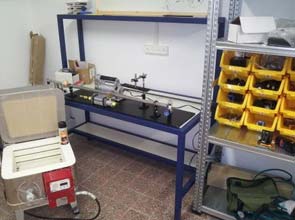
Architecture will lose its formal rigidity, softening and flexing and getting closer to the life we see in plants.
As scientists make huge strides in robotics, natural building materials, and new construction methods, our urban architecture could take on a much different form than the rigid construction we’re used to.
As complex ecosystems, cities are confronting tremendous pressures to seek optimum efficiency with minimal impact in a resource-constrained world. While architecture, urban planning, and sustainability attempt to address the massive resource requirements and outflow of cities, there are signs that a deeper current of biology is working its way into the urban framework.
Innovations emerging across the disciplines of additive manufacturing, synthetic biology, swarm robotics, and architecture suggest a future scenario when buildings may be designed using libraries of biological templates and constructed with biosynthetic materials able to sense and adapt to their conditions. Construction itself may be handled by bacterial printers and swarms of mechanical assemblers.
Much of the modern built environment we experience began its life in CAD software. In the Bio/Nano/Programmable Matter lab at Autodesk Research, engineers are developing tools to model the microscopic world. Project Cyborg helps researchers simulate atomic and molecular interactions, providing a platform to programmatically design matter. Autodesk recently partnered with Organovo, a firm developing functional bioprinters that can print living tissues. This pairing extends the possibilities from molecular design to biofabrication, enabling rapid prototyping of everything from pharmaceuticals to nanomachines.
Tools like Project Cyborg make possible a deeper exploration of biomimicry through the precise manipulation of matter. David Benjamin and his Columbia Living Architecture Lab explore ways to integrate biology into architecture. Their recent work investigates bacterial manufacturing–the genetic modification of bacteria to create durable materials. Envisioning a future where bacterial colonies are designed to print novel materials at scale, they see buildings wrapped in seamless, responsive, bio-electronic envelopes.
From molecular printing to volume manufacturing, roboticist Enrico Dini has fabricated a 3D printer large enough to print houses from sand. He’s now teamed up with the European Space Agency to investigate deploying his D-Shape printer to the moon in hopes of churning lunar soil into a habitable base. Though realization of this effort remains distant, it’s notable to show how the thinking–and money–is moving to scale 3-D printing well beyond the desktop.
While printers integrate new materials and scale up to make bigger things, another approach to construction focuses on programming group dynamics. Like corals, beehives, and termite colonies, there’s a scalar effect gained from coordinating large numbers of simple agents towards complex goals.
The Robobees project at Harvard is exploring micro-scale robotics, wireless sensor arrays, and multi-agent systems to build robotic insects that exhibit the swarming behaviors of bees. They see a future where “coordinated agile robotic insects” are used for agriculture, search and rescue, and (of course) military surveillance. Taking a cue from mound-building termites, the TERMES project is developing a robotic swarm construction system. The team is working to get cooperative robots building things bigger than themselves by mapping the rules underlying emergence in autonomous distributed populations. Mike Rubenstein leads another Harvard lab, Kilobot, creating a “low cost scalable robot system for demonstrating collective behaviors”. His lab, along with the work of researcher’s like Nancy Lynch at MIT, are laying the frameworks for asynchronous distributed networks and multi-agent coordination, aka swarm robotics.
The Latest Bing News on:
Cities Of The Future
- Phoenix wants to build one of the world's largest water recycling plants. That's a game changeron April 26, 2024 at 6:01 am
Opinion: Sending ultra-purified recycled water directly to taps could change metro Phoenix, even if it remains a fraction of the water we drink.
- Jury selected for first Feeding Our Future trial after unusually long process due to publicity of massive fraud caseon April 25, 2024 at 2:06 pm
More than 70 Minnesotans were questioned in an unusually long four-day process to select a jury for the first Feeding Our Future trial due to the high publicity in the massive case.
- Want To See The Future Of Office Wear? Go To Napleson April 24, 2024 at 2:56 pm
(NAPLES, Italy) Sometimes, from great catastrophes comes epic renewal. Take Pompeii, the bustling Roman town famously wiped out in a volcanic eruption in 79 AD. Its well-preserved ruins remain a ...
- As the climate changes, cities scramble to find trees that will surviveon April 24, 2024 at 9:25 am
Climate change is scrambling the seasons, wreaking havoc on trees. Some temperate and high-altitude regions will grow more humid, which can lead to lethal rot. In other temperate zones, drier springs ...
- Foot Locker debuts 'store of the future' as it looks to win back Wall Street's confidenceon April 24, 2024 at 5:00 am
Foot Locker unveiled its "store of the future" concept that will inspire the revamping of 900 stores the sneaker retailer is planning over the next two years.
- Are floating cities the future of urban living?on April 20, 2024 at 2:21 pm
Dutch architect, Koen Olthuis has set his sights on the worlds rapidly rising sea levels - not on battling these forces but harnessing them as the basis for a new architectural revolution - ...
- UN’s Summit of the Future, EU regions and cities preparing for SDG upgradeon April 18, 2024 at 7:55 pm
September in New York, hosted by the UN General Assembly. It provides a high-level forum to determine the next steps in achieving all 17 sustainable development goals.
- As suburbs age, cities ponder the future of their community centerson April 17, 2024 at 9:00 pm
Twin Cities suburbs that boomed in the 1990s built shiny new community centers as a place for residents, ranging from teens and young families to seniors, to congregate ...
- The luxury hotspots of the futureon April 17, 2024 at 9:31 am
In Chengdu, the capital city of southwestern China’s Sichuan province, there is a subterranean playground for luxury brands. Beneath acres of luscious green parkland and water sculptures lies the SKP ...
- Report: Quad Cities to be 'warmer and wetter' in future decades because of climate changeon April 17, 2024 at 6:40 am
More intense flooding, drought and hotter temperatures are expected in the Quad-Cities in the coming decades as a result of climate change, according to a new report.
The Latest Google Headlines on:
Cities Of The Future
[google_news title=”” keyword=”Cities Of The Future” num_posts=”10″ blurb_length=”0″ show_thumb=”left”] [/vc_column_text]The Latest Bing News on:
Robotic swarm construction
- Building a better (robot) lawn moweron April 28, 2024 at 5:36 am
Buzzy new robotic lawn mowers let you use a smartphone app to boss them around, no perimeter wires required. Why it matters: The perfectly coiffed green lawn that these mowers enable is a joyous ...
- Festo Unveils Its Smallest Flying Creation: Bionic Honeybees That Fly in Coordinated Swarmon April 24, 2024 at 9:25 am
Festo's Bionic Learning Network has been focusing on the fascination of flying. In addition to the technical decoding of bird flight, the team has researched and technologically implemented numerous ...
- Autonomous flying in a swarmon April 24, 2024 at 5:25 am
To fly in a swarm, the bees follow the paths specified by a central computer. To ensure safe and collision-free flight in close formation, a high degree of spatial and temporal accuracy is required.
- How Nvidia Overtook Europe's Theme, Sector ETFson April 22, 2024 at 5:00 am
Nvidia’s role in this has been anything from tangential. While its weight in CHIP’s underlying index more doubled from 14% to 34%, data from Bloomberg and Amundi revealed a considerable 74% of the ETF ...
- Shimizu Corporation revolutionises construction with innovative 3D printing robotson April 21, 2024 at 3:01 am
At construction sites, Shimizu Corporation addresses labour shortages by employing 3D printing robots.These robots translate digital design data into architectural structures, including walls and ...
- What You Need to Know About Multifactor Authentication Fatigue Attacks and How they can be Preventedon April 17, 2024 at 11:49 pm
Kindly share this postMultifactor authentication is a security measure that requires users to provide a second form of verification before they can log into a corporate network. It has long been ...
- Robotic Layouts are Driving Significant Improvements in Constructionon April 16, 2024 at 9:47 am
Digital innovation, like HP SitePrint, is transforming the construction industry with autonomous capabilities that help firms meet their short and long terms goals. Read the ...
The Latest Google Headlines on:
Robotic swarm construction
[google_news title=”” keyword=”robotic swarm construction” num_posts=”10″ blurb_length=”0″ show_thumb=”left”]










